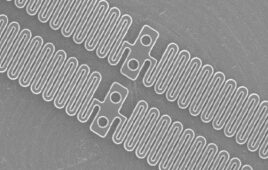
These scanning electron microscope images show silk-coated microcapsules containing vitamin C at different scales of detail. Left and top center: samples made by spray drying; Right and bottom center: samples made by ultrasonic spray freeze drying. [Images courtesy of MIT]
As scrutiny of microplastics mounts for their health and environmental impacts, a team of researchers are looking into silk protein as a naturally biodegradable alternative.
Silk protein fiber can be used as a nontoxic, delayed-release coating that’s safe for medical use instead of microplastics. That’s according to findings recently published in the journal Small by MIT postdoc Muchun Liu, MIT Civil and Environmental Engineering Professor Benedetto Marelli and five employees of German chemical conglomerate BASF.
Microplastics — solid, insoluble and nonbiodegradable plastic particles of up to 5 mm in size — are most known for their use in beauty products (though banned in the U.S.), synthetic textiles and industrial manufacturing. They are eventually found in any plastic product — like medical product packaging and face masks — that breaks down into smaller and smaller pieces by physical stress, ultraviolet light and other forces. And they are also used in pharmaceuticals for controlled delivery.
The researchers said the microencapsulation technology shows the most potential for agriculture, noting that the structural protein’s polymorphic properties also make it a strong candidate for biomedical and optoelectronic applications.
“There is a strong need to achieve encapsulation of high-content actives to open the door to commercial use,” Marelli said in an MIT news release. “The only way to have an impact is where we can not only replace a synthetic polymer with a biodegradable counterpart, but also achieve performance that is the same, if not better.”
Dissolving silk cocoons and processing the silk fibers is “so simple and tunable that the resulting material can be adapted to work on existing manufacturing equipment, potentially providing a simple drop-in solution using existing factories,” MIT said in a news release, further explaining:
“By precisely adjusting the polymer chain arrangements of silk materials and addition of a surfactant, it is possible to fine-tune the properties of the resulting coatings once they dry out and harden. The material can be hydrophobic (water-repelling) even though it is made and processed in a water solution, or it can be hydrophilic (water-attracting), or anywhere in between, and for a given application it can be made to match the characteristics of the material it is being used to replace.”
Further investigation will focus on variables such as “microcapsule size, wall thickness, and payload content on release profiles, together with the influence of other payload types, such as nanostructured inorganics,” the researchers said.




